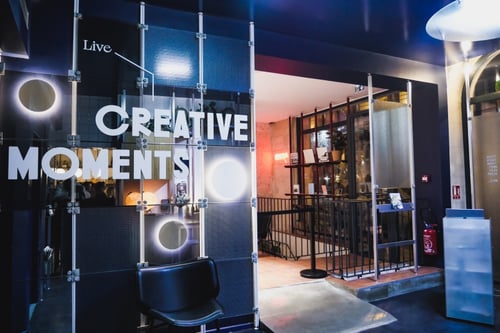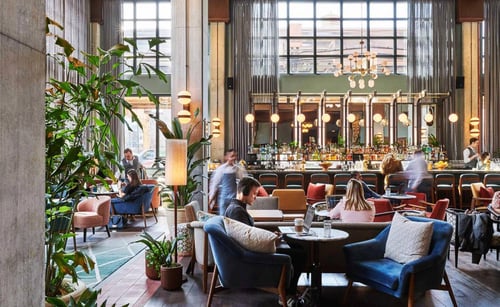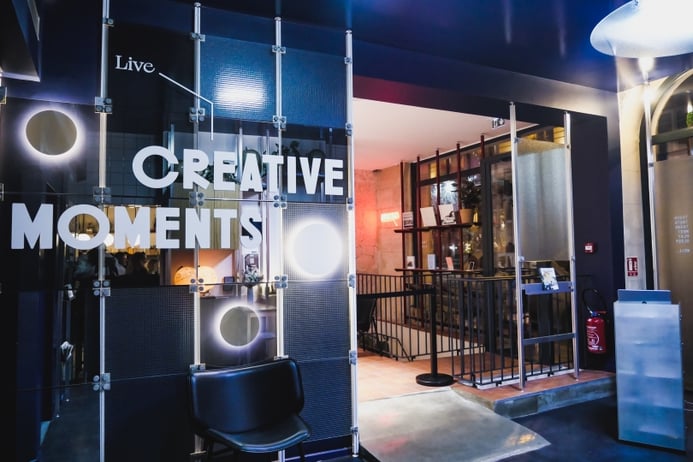Designing Hotel and Restaurant Concepts is a 3-day short course taught on EHL Campus in Singapore and Lausanne by Youri Sawerschel. A flagship course of EHL’s executive school, it specializes in expanding concept mindsets with regards to hotel, restaurant and retail spaces. By looking at new ways of managing hotel design, operations, strategy and services from a creative storytelling and interlinked perspective, participants (often industry professionals – but not always) walk away with new mindsets for future hospitality concepts. A feature of the course is an overview of the seven components that help design a successful and engaging hotel concept.
The seven components of hotel concept design
Starting from the central story, components are interconnected and work side by side to build a unique, coherent whole.
The hotel concept story
The Story defines the role of a hotel as well as its aspirations. In other words, your story should convey why guests should stay at your property, beyond just getting a room and breakfast.
Having a good story presents a number of clear advantages:
- A story lasts virtually forever and can evolve.
- A story is hard to copy and can increase awareness around your property.
- A story is inexpensive to create, in relation to the overall cost of building or renovating a hotel.
- A story can trigger an emotional response and decrease price sensitivity.
- A story is engaging and gives journalists a reason to follow you over the years.
To create an engaging – and lasting – story, it is important to make it the starting point of your concept building process. The story is like a golden thread connecting all the components of your concept, hence the importance of having a clear picture of it before working on the rest. A story should consider the hotel’s customer segments, staff and management, as well as its location and infrastructure. For instance, centering a story around avant-garde street art would not be consistent with an airport hotel run by conservative founders.
“A story conveys why guests should stay at your hotel, beyond the bed and breakfast.”

It’s important not to confuse story and theme. Themed hotels try to recreate a set universe (mainly through design), but few of them take the time to work on their story. A champagne themed or sailing themed hotel might appeal to some onetime guests, but how often would you want to visit ? A good story does not have to be literal, but it must be engaging. Over time and with the passage of guests, it will ripen and evolve.
French Theory is a new hybrid hospitality concept that recently opened their first hotel in Paris. We helped develop a story that revolves around rekindling the cultural appeal of the Parisian Left Bank, with a focus on music and art. It encourages guests to “live creative moments”. Experiences tied to the story are built into every aspect of the hotel, from in-room art by local artists to a basement hi-fi listening room and recording studio.
People: At the core of all interactions
The People component encompasses all the people who play a part in your hotel concept: Your employees, your guests, your partners and, to a certain extent, your investors. Together, they bring your concept to life. In most hotel concepts, people are at the core of all interactions.
"Hotels might sell rooms, but relationships are the real currency."
The people you hire and collaborate with must all feel connected to your story. A hotel that tells a story about “connecting people and ideas” could involve local entrepreneurs, academics and venture capitalists. A hotel wishing to “lead people to better health” may partner with medical professionals, yoga studios or fitness coaches.

You should also define who your core target customer group is (the people who connect perfectly to your story) early on. It will help you make decisions about all other aspects of your hotel concept. For example, a hotel centered around art and culture should have a core customer base made up of art curators, gallerists and journalists, and create experiences tailored to that group.
All too often, managing people is seen as a purely operational issue, primarily centered around skill training to increase quality and consistency of service. But intangible elements, like beliefs and shared values, can also significantly impact the customer experience.
The Hotel Europe in Zurich has been an independent, family-run hotel for generations, something the owners and staff take pride in. We helped the owners put this legacy at the center of their concept, and position their property as an authentic, historical hotel with a strong family feel.
Space: More than stunning interiors
In our model, the Space component relates to the physical makeup of the hotel. It encompasses the zoning, the customer flow of a hotel, as well as its interior design. A hotel space must match with its core story: a “rebel story hotel” should be designed differently than 'a conservative elite hotel'.
“Your hotel space must be aligned with your core story.”
Zoning is the first and most essential step to planning your hotel space, as it greatly impacts the customer experience. Different spaces have different purposes and require sensible placing: a quiet library space will not do well if located next to a busy restaurant or hotel bar. Refining your customer flow allows guests to circulate smoothly between different zones, which reduces stress and can create new opportunities for generating revenue.
Interior design should come last in the space design process. The brief should consider the story, as well as both zoning and customer flow. Integrating these variables upstream of the design process lets interior designers focus on aesthetic quality to bring your story to life with the right combination of furniture pieces, textiles, materials and decorative objects.
Consider cultural and social norms when designing a space. Narrow corridors and dim lighting will encourage your guests to be quiet, while a bar area with high stools and loud music will encourage social interaction.
![]() The Hotel Koé in Shibuya, Tokyo, is a great example of mindful spatial design. Their hotel concept revolves around “new basics for new culture”, merging hospitality, retail, food and entertainment under one roof. The space has been designed to balance efficiency and revenue generation with guest privacy and comfort: the ground floor houses a bar-restaurant-bakery space that draws in outside traffic. Above, the first floor is dedicated to Koé’s eponymous fashion label, while the hotel reception and rooms are located on the upper floors. This protects guests from the hustle and bustle of the street below.
The Hotel Koé in Shibuya, Tokyo, is a great example of mindful spatial design. Their hotel concept revolves around “new basics for new culture”, merging hospitality, retail, food and entertainment under one roof. The space has been designed to balance efficiency and revenue generation with guest privacy and comfort: the ground floor houses a bar-restaurant-bakery space that draws in outside traffic. Above, the first floor is dedicated to Koé’s eponymous fashion label, while the hotel reception and rooms are located on the upper floors. This protects guests from the hustle and bustle of the street below.
Identity: A hotel’s look and feel
The Identity element in the framework encompasses all the graphic, verbal and sensorial aspects of a hotel concept. From corridor signage to website layout and up to the hold music, each and every ingredient is an opportunity for a hotel to assert its unique identity. Since these items are experienced by guests before, during and after their stay, the identity they express must be fully coherent with the story of your hotel.
“The identity must be fully coherent with the story of your hotel.”
Visual identity plays a particularly important role in creating an identity. It also contributes to your hotel’s perceived value: stellar website design is good advertising in and out of itself. The visual identity you develop also extends to the content you create. Your Instagram posts, trade show banners, YouTube videos - make sure that your content is always “onbrand”. Repetition and consistency will help ingrain your concept into the minds of your customers. An often overlooked but highly effective way to build a special connection with your guests is your sensorial identity. The scent of fresh croissants in the morning might convince a guest not to skip breakfast. Replacing the complimentary chocolate by a local delicacy may create an extra connection with your surroundings. Even the choice of toilet paper can have unexpected effects on your guests’ wellbeing.
Clichés and stereotypes can ruin an otherwise authentic experience. Be sure to avoid pictures of soulless city views – or worse, stock images – and do not use local landmarks as a replacement for a hotel logo. Sensorial experiences need to be subtle too. A funky playlist can enliven your bar in the evening, but is likely to drive away guests if it’s playing the next day at breakfast. Pay particular attention to the smell and composition of bathroom products: nothing ruins a good shower like blatantly artificial fragrances and a dry scalp.
![]() The Fife Arms Hotel is a luxury hotel in the Scottish Highlands, housed in a restored Victorian coach inn. It boasts a consistent identity across all touch points and a story about connecting heritage, hospitality and contemporary art. Everything from their website to their luggage labels has been designed or curated to fit with the hotel concept. The hotel even created its very own Scottish tartan, used for staff uniforms and bed covers. To complete the picture, staff are encouraged to speak with a strong Scottish accent to keep the original soul of the place alive.
The Fife Arms Hotel is a luxury hotel in the Scottish Highlands, housed in a restored Victorian coach inn. It boasts a consistent identity across all touch points and a story about connecting heritage, hospitality and contemporary art. Everything from their website to their luggage labels has been designed or curated to fit with the hotel concept. The hotel even created its very own Scottish tartan, used for staff uniforms and bed covers. To complete the picture, staff are encouraged to speak with a strong Scottish accent to keep the original soul of the place alive.
Hotel services offering
The framework’s Services component covers the services and amenities offered to guests before, during and after their stay. Spanning everything from the essential (Wi-Fi, housekeeping) to the exotic (dog concierge, selfie assistant), services offer a myriad of possibilities for guest interactions, and help enrich the customer experience. Of course, services that tie in with your hotel story are particularly valuable, as they can strengthen your overall concept. In-room poker sets and whisky tastings will bring a distinctive appeal to a hotel whose story revolves around “great times with friends”
When building a hotel concept, the level of services offered is an important consideration. Depending on your positioning and target audience, you could settle on anything from the barebone experience of a no-frills hostel or motel to the “your-wish-is-my-command” approach of some palace hotels.
“Consider which services actually add value to the guest experience.”
The degree of technology is also important. While a free – and reliable – Wi-Fi connection is now considered a commodity in most hotels, some establishments also offer Bluetooth speakers, connected TVs with Netflix or Apple TV, or chatbot concierges available anytime, anywhere. It’s important to consider which of these services actually add value for your guests, and whether they make sense in relation to the story. Signature services are often exclusive to a specific hotel or location. When devised as an extension of the hotel story, they can leave a lasting impression on the customer and generate great PR value. For instance, a wilderness retreat could offer a digital detox kit for guests wishing to reconnect with nature.
Start with the basics. It doesn’t matter how exhaustive your service catalogue is, if the bedroom is dirty or the water cold, your customers won’t be back. Structure your offering with different service levels, from essential to nice-to-have, and make sure you deliver on what you promise. In a similar logic, always stop to consider how your services match with your story, your positioning and your audience. A good service offering should be an investment, not a burden.
The Ritz Carlton chain empowers its employees by allowing them to spend up to $2,000 per guest, per incident, in order to improve or fix an aspect of the customer experience, without having to ask a higher-up for approval. This lines up perfectly with the “Ladies and Gentlemen serving Ladies and Gentlemen” story of Ritz Carlton.
Content: All year round customer engagement
Our framework’s Content component defines the intellectual property and communication assets a hotel develops. These come in many forms, from website articles to a a line of fashion accessories. You might have a weekly podcast series about unconventional travel destinations or perhaps a short documentary showcasing your region. Good content can help you showcase multiple facets of your story, which helps to educate your target audience, improves your brand’s reputation, and generates free press. It will also help you stay in touch with your guests even if they’ve only been to your property once.
“ Content creation rarely generates instant results. It’s a marathon, not a sprint.”
When creating content, it’s important to make sure it aligns with your story and that the format is consistent with your identity. This creates a positive feedback loop around your key messages, giving a valuable boost to your visibility and reputation. You do not have to create and distribute content all by yourself. If the story you tell is compelling, it will attract attention from newspapers and influencers on the lookout for the next hidden gem. You can also leverage your local network by partnering up with associations, university students or local businesses to create content for you. If you can create value for the community, the community will help spread your name.
Keep in mind that content creation rarely generates instant results. You should consider it as a long-term investment that will help you secure a desirable position in the future. It’s a marathon, not a sprint.
 Eaton Workshop, a brand with hotels in Hong Kong and Washington, D.C., has mastered the art of content creation. Driven by the belief that the hospitality industry can be a “regenerative catalyst of positive impact, for guests, the local community, and the environment”, Eaton Workshop has created its very own media arm. It houses a recording studio and runs a radio station. The hotel regularly welcomes its guests to take part in radio programmes and invites artists to record soundtracks.
Eaton Workshop, a brand with hotels in Hong Kong and Washington, D.C., has mastered the art of content creation. Driven by the belief that the hospitality industry can be a “regenerative catalyst of positive impact, for guests, the local community, and the environment”, Eaton Workshop has created its very own media arm. It houses a recording studio and runs a radio station. The hotel regularly welcomes its guests to take part in radio programmes and invites artists to record soundtracks.
Channels to broadcast your story
The Channel component in our framework encompasses all digital channels as well as the real-world activities and events a hotel organises to bring their story to life. From your OTA booking page to your end-of-year theme party, channels represent all the marketing touchpoints between you and your guests.
Digital channels include booking platforms and social media accounts – they are crucial to hotel management. But the overwhelming amount of information available online makes it incredibly difficult to create an emotional connection with guests via these channels alone. Face-to-face interactions are hard to beat when it comes to engaging people. These elements combined will make the story come alive. Depending on your story and concept, possible activities might include a flea market, movie nights, modern art exhibitions or outdoor pilates classes.
Channels can also take the form of collaborations and, in certain cases, drive direct bookings to your hotels. If you run a wellness resort, for example, you could ask yoga studios in your feeder markets to refer customers to your establishment in exchange for a commission. Turning collaborations into distribution channels works best if the hotel story matches with the partner story (shared beliefs), making the commercial nature of the relationship less obvious to customers.
“Channels represent all the marketing touchpoints between you and your guests.”

To avoid a disconnect between strategy and operations, Story, Content and Channels should always work hand-in-hand. Inviting a jazz band to play in the lobby of your airport hotel on Saturday nights might help you sell more beer, but if jazz has no connection with your story, it won’t help strengthen your concept over the long term.
The Hoxton Hotel Group provides a wide range of events for its cosmopolitan and entrepreneurially-minded guests. And while events vary from location to location (basement electro parties in Paris, sustainable cocktail classes in L.A.), a handful of common signifiers help reinforce the brand story and identity (live jazz, entrepreneurial talks, etc.).
This article is extracted from the Hotel Concept Handbook, developed by Creative Supply in partnership with EHL and has been used to create winning hotel concepts. For hoteliers, it helps to create integrated, compelling concepts that attract the interest of guests and industry professionals alike by linking storytelling to operations or design. The Hotel Concept Framework is taught every year to students at EHL.






